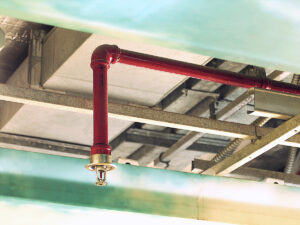
Fire sprinkler system installation can be a lengthy and in-depth process.
We previously discussed the steps for pre-installing a fire sprinkler system. It may seem strange that pre-installation is often the longest and most difficult part of fire sprinkler system installation, but it’s true! Once pre-installation has been completed, the final step is installing the sprinkler system. Installation time and difficulty vary depending on the type of fire sprinkler system being installed, the facility, and any local fire codes that need to be followed. However, there is a general overview of processes that happen in every sprinkler installation.
Installation of the Sprinkler System
With the permits approved, the actual installation of the fire sprinkler system can begin. The installation process typically involves several key steps:
- Preparation: Before installing the pipes and sprinkler heads, the installation team will prepare the site. This may include laying protective coverings to prevent damage to floors or walls and moving any obstacles that could interfere with the installation process.
- Piping Installation: The first major task is installing the network of pipes that will supply water to the sprinkler heads. This often involves cutting into ceilings or walls to run the pipes, which are typically made from steel, copper, or CPVC. In some cases, additional supports or hangers may need to be installed to ensure the piping is securely fastened.
- Sprinkler Head Installation: Once the piping is in place, the sprinkler heads are installed according to the design plan. Sprinkler heads are strategically positioned to provide maximum coverage and are available in various styles to suit different applications and aesthetics.
- Connection to Water Supply: The system is connected to the building’s main water supply or a dedicated water source, such as a water tank or pump. This step may also involve installing backflow prevention devices to ensure the water supply remains uncontaminated.
System Testing and Inspection
After installation, the fire sprinkler system must undergo thorough testing and inspection to ensure it operates correctly. This process includes:
- Hydrostatic Testing: The pipes are filled with water and pressurized to check for leaks. Hydrostatic testing ensures that the piping can withstand the pressure needed to operate the system during a fire.
- Flow Testing: The system is tested to verify that water flows properly from the sprinkler heads. This test confirms that the system will activate as intended in an emergency.
- Inspection by Local Authorities: In many areas, a representative from the local fire department or another regulatory body must inspect the installed system to ensure it meets all codes and standards.
Final Adjustments and Training
Once the system passes all tests and inspections, the fire protection company will make any necessary adjustments to optimize performance. They will also provide training on how the system operates, including how to perform routine checks, handle basic maintenance, and respond in the event of an alarm or system activation.
Ongoing Maintenance and Inspections
After the installation is complete, regular maintenance and inspections are essential to keep the fire sprinkler system in good working order. Most fire codes require annual inspections, but you should also perform periodic checks to ensure the system remains operational and free of obstructions or damage.
Fire Protection Services from Fireline
Whether you need smoke detectors, fire extinguishers, or an automatic sprinkler system installed at your commercial property, Fireline has you covered. We have been protecting people and property from fire damage since 1947—and our experience shows in our excellent work! We are known for our superb customer service, our expertise, and our reliability. For more information on how we can help your residential or commercial property, visit us online or give us a call at (800) 553-3405. We are in Baltimore, MD, with a second office in Leesburg, VA. For more fire safety tips, be sure to follow us on Facebook, Twitter, and LinkedIn.
